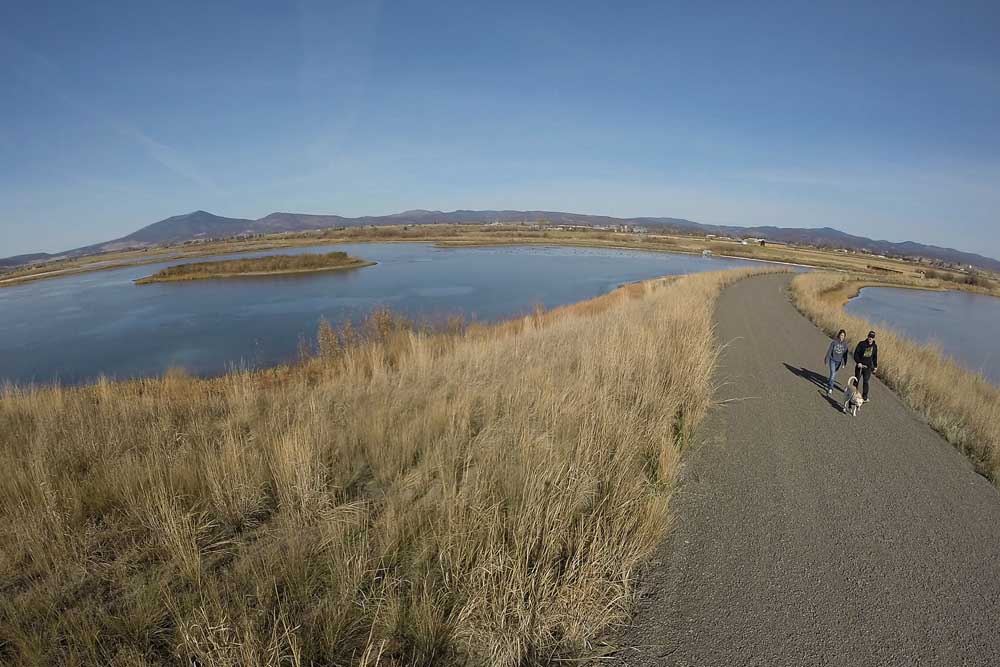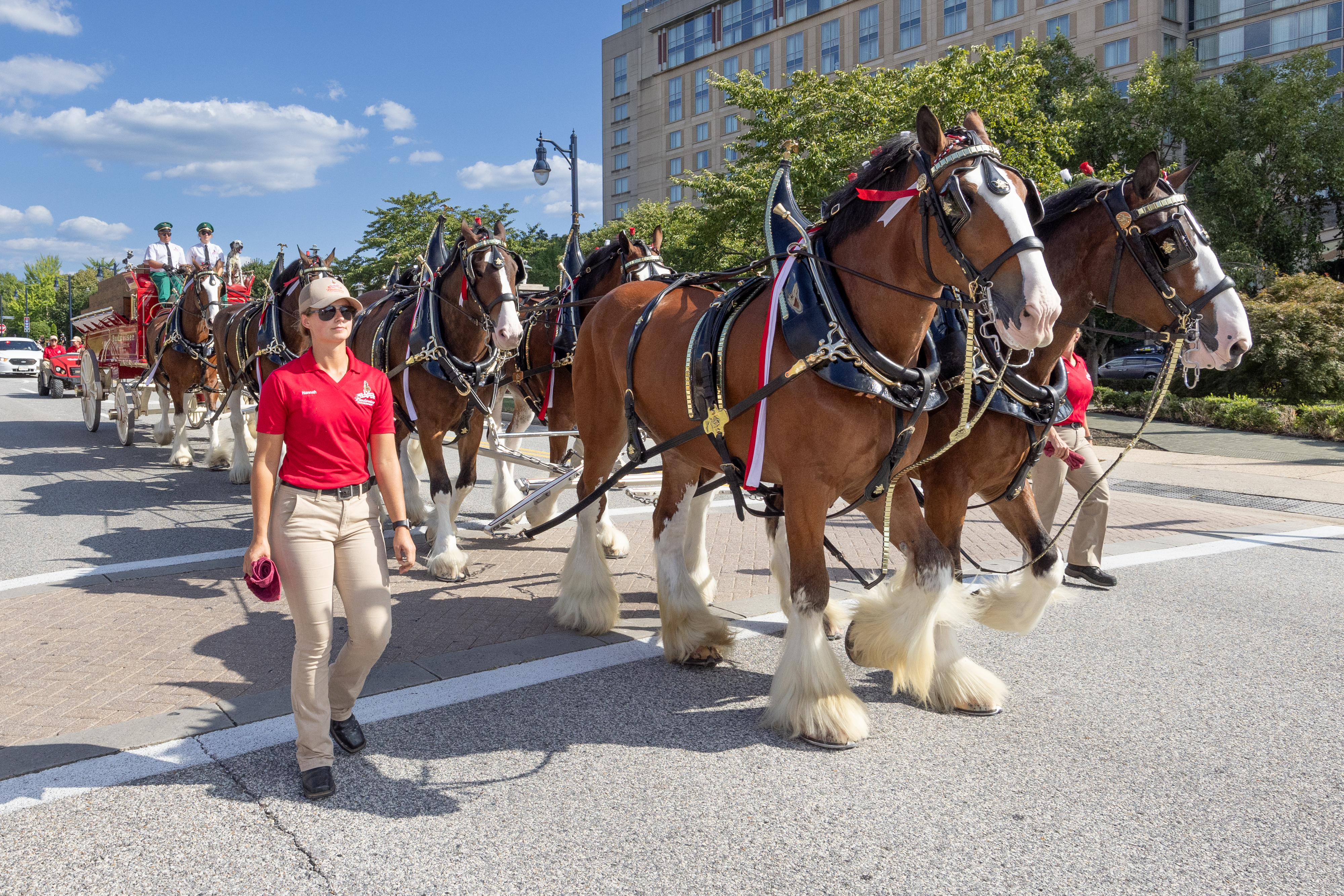Redmond aims to turn waste into wetland park
Published 7:30 am Tuesday, November 8, 2022

- FILE- Prineville residents Rich Dyer and his daughter Julie Dyer walk along a trail in the Crooked River Wetlands Complex with their dog Gunner in 2019.
Beneath the streets of Redmond, wastewater and sewer lines feed into a system approaching capacity. If maxed out, it could open the city to potential public health and environmental consequences and permit violations.
Trending
By 2045, Redmond’s population is expected to hit 53,800 residents who will produce 4.67 million gallons of wastewater every day. Currently, Redmond’s capacity is 2.8 million gallons a day and, if the population keeps growing at the same pace, is expected to max out in three to five years.
With a tight deadline for the rapidly expanding city, Ryan Kirchner, wastewater division manager for the city of Redmond, is heading the charge toward a new, more natural sewer system called the Redmond Wetlands Complex.
The roughly 1,200-acre complex, which would be located at 5801 NW Way, would treat wastewater — used water that requires treatment such as from toilets, showers and kitchen sinks — using ponds and wetlands. Water would travel from the city collection system, through screening and five aerated lagoons before being chlorinated. The water would then be sent to either a storage lagoon for irrigation supply or to publicly-accessible treatment wetlands, which would drain into the ground
Trending
The $70 million complex is inspired by Prineville’s Crooked River Wetlands and similar natural treatment systems. The complex would also create a natural habitat for birds and wildlife as well as offer walking trails and educational opportunities.
“To do something that the community now can actually enjoy and be a part of it instead of just seeing it behind the fence is pretty special,” Kirchner said.
The final design includes 90 acres of wetland habitat, four miles of paved and gravel trails that could connect to the Dry Canyon, educational kiosks, picnic areas and shelters.
Also included in the design is new wastewater division facilities and maintenance buildings.
The cost
The city’s current mechanical system relies on chemical and microbial treatment. But as the city swells in population it had two options: upgrade the current system or build the wetlands.
It would cost $104 million to upgrade the current system and raise residents’ monthly sewer bill. And, since space to expand is limited at the current site, the city would need to continuously pour money into increasing the technology of the facility to do more with less.
Additionally, they would need to add one or two staff members. The $70 million wetland complex, on the other hand, would simplify the process and allow the wastewater division to reduce their staff by one person — helping keep residents’ sewer bills the same for now.
“There’d be a significant difference in the rate in comparison to moving here and building this system versus expanding at the current site,” Kirchner said.
Redmond, he said, has the lowest sewer rates in Central Oregon, with most people paying around $33 a month. In cities like Madras, Bend and Prineville, the average cost is around $50.
“It’s a natural treatment system,” Kirchner said. “It’s got a lower initial cost and a lower life cycle cost and what that ends up doing is it’s stabilizing the rates for the city of Redmond and keeping a focus on trying to maintain low rates for the community.”
At the current mechanical facility, it takes about a day and a half to treat the city’s wastewater while the wetlands would take anywhere from 30 to 60 days.
Going with the wetlands rather than the mechanical expansion, Kirchner said, would result in about half a million dollar savings per year.
The majority of the funding for the project, Kirchner said, would come from a low-interest loan from the Department of Environmental Quality’s Clean Water State Revolving Fund.
“At this time, we’re not going to have to make any significant change to the rate structure to afford to pay off that loan,” he said.
The city plans to decommission the current facility and could repurpose some structures for future use.
The wetlands are not a new concept. Prineville was in a similar position in 2005 and tasked with creating a mechanical treatment facility for $62 million. According to Eric Klann, Prineville city engineer, that price tag was too high and they began looking into natural treatment options and settled on their current wetlands complex.
The total cost to the city after receiving grants: $4.2 million.
Klann said the project “saved us a boatload of money.”
Klann added that the complex received the Environmental Protection Agency’s PISCES Award as one of the top five environmental projects in the nation.
“We’re pretty proud of it,” he said. “Our facility just turned into a wonderful park. We have people out there every day walking.”
Concerns and limitations
Kirchner said there have been few who oppose the wetlands but that most concerns are about the smell, mosquitoes or vandalism.
“We were all pretty concerned about the odor and what it’s going to do to our aquifer and our groundwater,” said Randy Marvin, who has lived in Tetherow Crossing near the proposed site since 2005.
But Marvin visited the Crooked River Wetlands Complex in Prineville with his wife to see what the Redmond complex could be like and said it completely changed his mind.
“I was really impressed with the wetlands,” he said. “I really think it’s a lot better system than the mechanical ones.”
Marvin said he couldn’t smell anything standing right next to the ponds and that he felt better after seeing the way they monitor the groundwater.
According to Klann, one of their biggest concerns building the complex was mosquitos and tested the site for five years, but found no increase in mosquitoes.
Klann noted that they did see an increase in midges, but have successfully controlled them.
“Our mosquitoes don’t necessarily (like) habitat like this,” said Kirchner. “They like the grass blades that are flood irrigated, so we’re not doing any flood irrigation.”
While some are concerned about increased vandalism, Kirchner and nearby residents believe the complex will actually decrease the number of people causing trouble.
Marvin and Kim Kathol, who has lived near the site for 13 years, said they hear people in the area every weekend driving ATVs and shooting guns.
“I think with a presence every day,” Kathol said, “(it) is going to make a difference.”
But, while the wetlands may provide an all-around benefit, they have their limitations for other cities that may try to follow suit.
Redmond, Kirchner said, is lucky that it already had the land available and that there were already gravity-fed pipelines going out to the site. The reason why most communities aren’t able to build a wetland treatment system, he said, is because they don’t have a big chunk of land set aside like Redmond.
“We got lucky,” he said.
According to Kirchner and the project’s website, construction would begin late next year and wrap up in early 2026 if all goes to plan.
Benefits
Linda Seeberg, executive director of academic achievement for the Redmond School District, said there are a lot of potential opportunities for students to learn about the environment and science with field trips to the nearby wetlands.
“It’s taking what is a required function… and turning it into something that is a benefit,” Seeberg said. “They’re doing a great thing. It’s a real value-added for a required function of a city.”
She added that RSD is hoping to work with schools in Prineville to learn how they’ve taken advantage of their own wetlands complex, such as how they made nests for aquatic birds and were able to collect data on how they were used. Prineville, she said, is already doing the work they hope to do.
And, since the site is less than a 15-minute drive from downtown Redmond, Seeberg hopes there would be more opportunities for parents to get involved in field trips.
“We’re excited for the opportunity of partnership,” Seeberg said. “I think that’s what builds strong communities – when we work together.”
Additionally, the wetlands would be a mecca for bird watchers, with members of the Audubon Society already heading to the site every day to do bird counts and try to spot unique birds.
Kim Kathol, who has been birding for 32 years, said he visits the site every day and has seen around 160 bird species already. But, he estimated that when the project is completed that there could be more than 200 bird species that flock to the wetlands.
“I’m excited,” Kathol said. “It’ll be changing for the better.”








